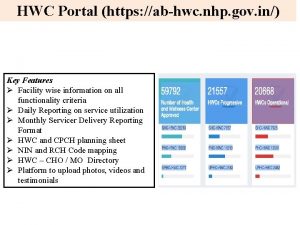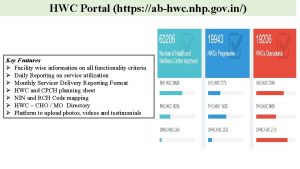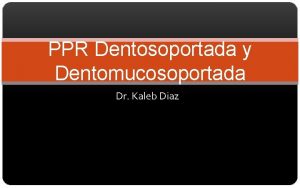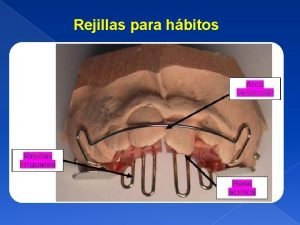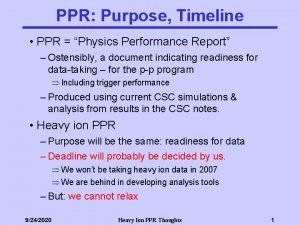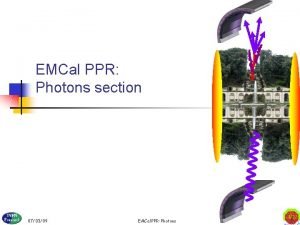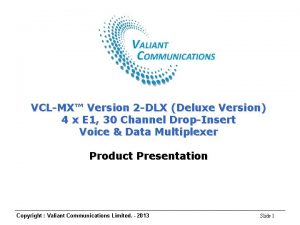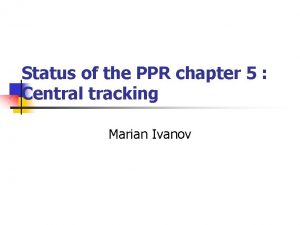PPR 6 1 status New version of PPR










- Slides: 10

PPR 6. 1: status • New version of PPR 6. 1 released today • Can be downloaded at /afs/cern. ch/alice/ppr/chap 6_1 dir/alice_chap 6_1_PB. ps (private use, not linked to the web page) • Working version • Indications on missing sections (short summary) • Notes on updates (mainly figures) that will be done later • In our opinion it is ready to be read • Comments/suggestions welcome • Final editing (position of figures inside text, size/fonts) to be done (but the situation is not too messy) • Will be done when the indications for text finalization will be definitive

Index slightly modified to accomodate updates in a more logical way

6. 1. 2. Centrality determination using the ZDC • Basically unchanged for what concerns the full simulation (based on 1000 HIJING events) • Set-up has slightly changed since then, but • small impact on performance expected • need time to re-do simulation (tracking of 2. 7 Te. V spectator nucleons) • Short subsection on correlation between the ZDC response on the two sides of the IP is being prepared

6. 1. 3. Multiplicity determination using the SPD and the FMD • Some plots have been recently updated (acceptance as a function of zv for SPD layers 1 and 2) • Would be interesting to have this info also for tracklets (probably dominated by layer 2 acceptance) • No major changes done recently or expected in the near future

6. 1. 4. Multiplicity vs centrality: a physics performance study • Study of the correlations multiplicity (SPD) vs centrality (ZDC) • Full simulation • Analysis performed in the Kharzeev-Nardi approach • No further update foreseen

6. 1. 5. Centrality determination: comparison between different estimators • New section, based on discussions at the March PWG 2 meeting • Implement a fast simulation, in order to study and compare the quality of the centrality measurement using: • multiplicity distribution in the SPD • correlations EZDC vs EZEM

6. 1. 6. Transverse momentum spectra • Short section containing some estimates of the high-p t yield • in absence of any quenching mechanism • as a function of centrality • No trigger selection criteria included (pure minimum bias) • Estimates are given for • charged particles (full tracking) • neutrals • prompt photons • 0

6. 1. 7. Global event properties in pp (1) • Update of PYTHIA (version 6. 214 instead of 6. 150; improvements in multiple parton interaction scenario). Retuned by ATLAS. • New reconstruction in TPC (M. Ivanov) • New IO (with ESD output files). • Full reconstruction in all the detectors. • New vertex reconstruction (M. Masera-A. Dainese) • Performed some studies on trigger based on VZERO and T 0 hits. • Global PID from TPC, ITS, TRD, TOF, to be used • Multiplicity and d. N/d section (cluster counting, tracklets) • All figures have been updated (except a couple of them, to be improved) • Transverse momentum section • New plots for d. N/dp. T and momentum resolution • Larger sample and better reconstruction • Ratio of p. T distributions

6. 1. 7. Global event properties in pp (2) • Study of p. T vs multiplicity • New plots, still to be checked by Tiziano • Same plots for identified particles will come later • Phenomenological analysis of multiplicity (negative binomials, clans) • Shortened • We limit ourselves to a fit of multiplicity distributions obtained with the present data sample (PYTHIA 6. 214) (to be done) • Extrapolations to higher statistics (mult. , p. T) being done

6. 1. 8. Event centrality in p-A collisions • Based on gray/black track detection • No updates expected in the philosophy of the section • Small bug in the generation has been recently discovered • Beam crossing angle not taken into account properly • Simulations will be re-done • No major effect expected


